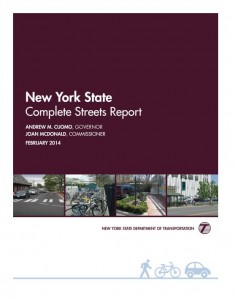 The New York State Department of Transportation released a report last week detailing how the Department has gone about implementing New York’s 2011 Complete Streets Act. The report, which NYSDOT is required by law to produce, elaborates on best practices and demonstrates the degree to which complete streets have been institutionalized and incorporated into all phases of transportation projects across the state.
The New York State Department of Transportation released a report last week detailing how the Department has gone about implementing New York’s 2011 Complete Streets Act. The report, which NYSDOT is required by law to produce, elaborates on best practices and demonstrates the degree to which complete streets have been institutionalized and incorporated into all phases of transportation projects across the state.
Perhaps the best news coming out of the report is the forthcoming Complete Streets Checklist, a potentially useful tool for institutionalizing complete streets design into the decision-making process. Its success will depend, however, on how pervasively it is used. At a minimum, to be compliant with the state complete streets law, all projects receiving state and federal funding would need to use the checklist, a fact not mentioned in the report.
The report does state, however, that “many Complete Streets improvements, such as lane striping, are relatively inexpensive but effective” techniques to improve accessibility for all users of the roadways. If NYSDOT mandates these basic improvements, which would reflect NYSDOT going above and beyond what the law requires, the checklist would then be required for all projects, including resurfacing, restoring and rehabilitation projects —which could easily incorporate complete streets elements with almost no additional costs. If NYSDOT opts out of this strategy, a bill on the table in Albany would require them to do so by amending the complete streets law to require inclusion of “complete street design features in resurfacing, maintenance and pavement recycling projects and further enable safe access to public roads for all users.”
During outreach meetings, stakeholders flagged the need for more outreach, education and coordination with local partners, and NYSDOT appears to have responded by identifying central staff who will be the go-to resource for questions about complete streets planning and design. NYSDOT will also hold workshops and informational meetings to train municipal staff across the state, which should help to alleviate some of the confusion that has arisen on implementation of the law. Although there have been some updates made to the highway design manual and engineering guidance issued by the state, like the phasing out of “Share the Road” signage, what is really needed is a comprehensive overhaul of the manual, which continues to provide conflicting information on complete streets methodologies.
The report says little about two major impediments to complete streets implementation in New York State: the inconsistency between the law and NYSDOT’s “preservation first” policy, which the report sidesteps entirely, and how the agency will fund pedestrian and bicycle projects. While the report does clearly identify funding as an issue that needs to be addressed…
NYSDOT and other agencies should address the perceived disconnect between the Complete Streets law and a lack of accompanying dedicated Complete Streets funding and help local agencies with funding hurdles.
…it fails to provide solutions to this dilemma. One clear opportunity would be to dedicate funding for bicycle and pedestrian infrastructure in the forthcoming 5-year capital plan.
The lack of insight into how the State will incorporate pedestrian and bicycle projects into the “Preservation First” policy was particularly disappointing to advocates, given that the policy categorically excludes new bicycle and pedestrian infrastructure from 80 percent of transportation funds spent in the State and public comment submitted by TSTC on the issue has yet to be responded to. Because of these unaddressed issues, this report is far off from receiving an A grade.

Nice to read of some progress on this front from the Tri-State Region. Not only does New York have a Complete Streets Law but the Legislature is looking to improve it.
New Jersey on the other hand….
[…] State DOT Sidesteps Key Funding and Policy Issues in Complete Streets Report (MTR) […]
[…] tons. After a recent win for Complete Streets on the Jersey Shore, we’re now working to ensure that NYSDOT fulfills its Complete Streets mandate for future […]
[…] above and beyond the dictates of the existing law by requiring all projects to use the forthcoming complete streets checklist. Thankfully, if NYSDOT doesn’t see the value in this simple fix, a bill (S6340/A8433) introduced […]
[…] Tri-State Transportation Campaign notes in their Mobilizing the Region blog, the most promising item in the report may be the Complete Streets Checklist, a tool which should […]